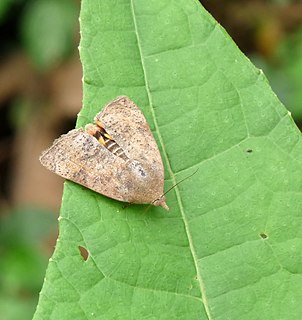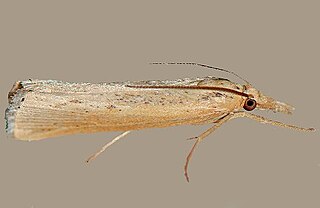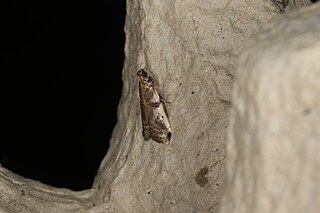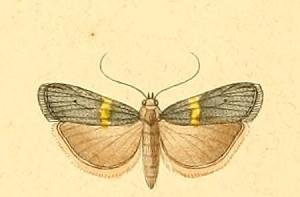
Hyblaeidae are the "teak moths", a family of insects in the Lepidopteran order. The two genera with about 18 species make up one of the two families of the Hyblaeoidea superfamily, which in the past has been included in the Pyraloidea. Recent phylogenetic studies find varying relationships of Hyblaeoidea among Ditrysian Lepidoptera: Mutanen et al. (2010) find the superfamily to group either with Pyraloidea, or – more often – with Thyridoidea or butterflies. The results of Wahlberg et al. (2013) and Heikilä et al. (2015) indicate a sister-group relationship with Pyraloidea.
Arequipa is a genus of moths of the family Crambidae. It contains only one species, Arequipa turbatella, which is found in North America, where it has been recorded from Alabama, Illinois, Maine, Maryland, North Carolina, Ohio, Ontario, Pennsylvania, Quebec and West Virginia.

Metoeca is a genus of moths of the family Crambidae. It contains only one species Metoeca foedalis, which has a wide distribution, including the Democratic Republic of Congo, Equatorial Guinea, South Africa, China, Japan, Taiwan, Thailand and Australia (Queensland).
Neargyrioides is a genus of moths of the family Crambidae. It contains only one species, Neargyrioides aglaopis, which is found in Australia, where it has been recorded from the Northern Territory and Queensland.

Niphograpta is a genus of moths of the family Crambidae. It contains only one species, the water hyacinth moth. It is native to the Amazon basin, but has been introduced in North America, Africa and Australia to control the spread of water hyacinth.

Perispasta is a genus of moths of the family Crambidae. It contains only one species, Perispasta caeculalis, or Titian Peale's pyralid moth, which is found in North America, where it has been recorded from Quebec west to British Columbia, south to Florida, Texas and Colorado. The habitat consists of fields and meadows. Both the genus and species were first described by Philipp Christoph Zeller in 1875.

Sclerocona is a genus of moths of the family Crambidae which contains only one species, Sclerocona acutella. It was first described by the Prussian biologist Eduard Friedrich Eversmann in 1842.
Tanaobela is a genus of moths in the superfamily Pyraloidea containing only one species, Tanaobela chrysochlora, which is found in Australia, where it has been recorded from Queensland. Its affiliations are disputed.

Tehama is a genus of moths of the family Crambidae. It contains only one species, Tehama bonifatella, the western lawn moth, which is found in Greenland and North America, where it has been recorded from Alberta, British Columbia, California, Colorado, Labrador, Manitoba, Nevada, Quebec and Washington. The habitat consists of grasslands.

Seeboldia is a genus of moths. Its only member is Seeboldia korgosella, a moth of the family Pyralidae. It is found in Europe, including France, Spain, Albania and Russia.

Assara seminivale, the kernel grub or macadamia kernel grub, is a species of snout moth in the genus Assara. It was described by Turner in 1904, and is known from Australia. There are also records for Sikkim, Tonkin, Sri Lanka, Sumatra and Borneo, but these need verification.
Cryptoblabes plagioleuca, the mango-flower moth, blossom moth or mango-flower webber, is a species of snout moth in the genus Cryptoblabes. It was described by Turner in 1904. It is found from Indonesia (Sumatra), New Hebrides, Australia and the Society Islands.

Sciota hostilis is a species of snout moth in the genus Sciota. It was described by Stephens in 1834. It is found in most of Europe.

Oxybia is a monotypic snout moth genus described by Hans Rebel in 1901. Its only species, Oxybia transversella, was described by Philogène Auguste Joseph Duponchel in 1836. It is found in southern Europe and on the Canary Islands.
Orthaga picta is a species of snout moth in the genus Orthaga. It was described by William Warren in 1895. It is found in Australia, including Queensland.
Orthaga erebochlaena is a species of snout moth in the genus Orthaga. It is found on the island of Java.
Orthaga seminivea is a species of snout moth in the genus Orthaga. It is found in Australia.

Paragalasa is a genus of moths of the family Pyralidae. It contains only one species, Paragalasa exospinalis, which is found in Arizona.
Nymphicula albibasalis is a moth in the family Crambidae. It was described by Yoshiyasu in 1980. It is found in Japan.

Sciota uvinella, the sweetgum leafroller moth, is a species of snout moth in the genus Sciota. It was described by Ragonot in 1887. It is found in North America, where it has been recorded from New Jersey to Florida, west to Texas and Kentucky.










